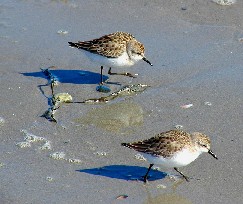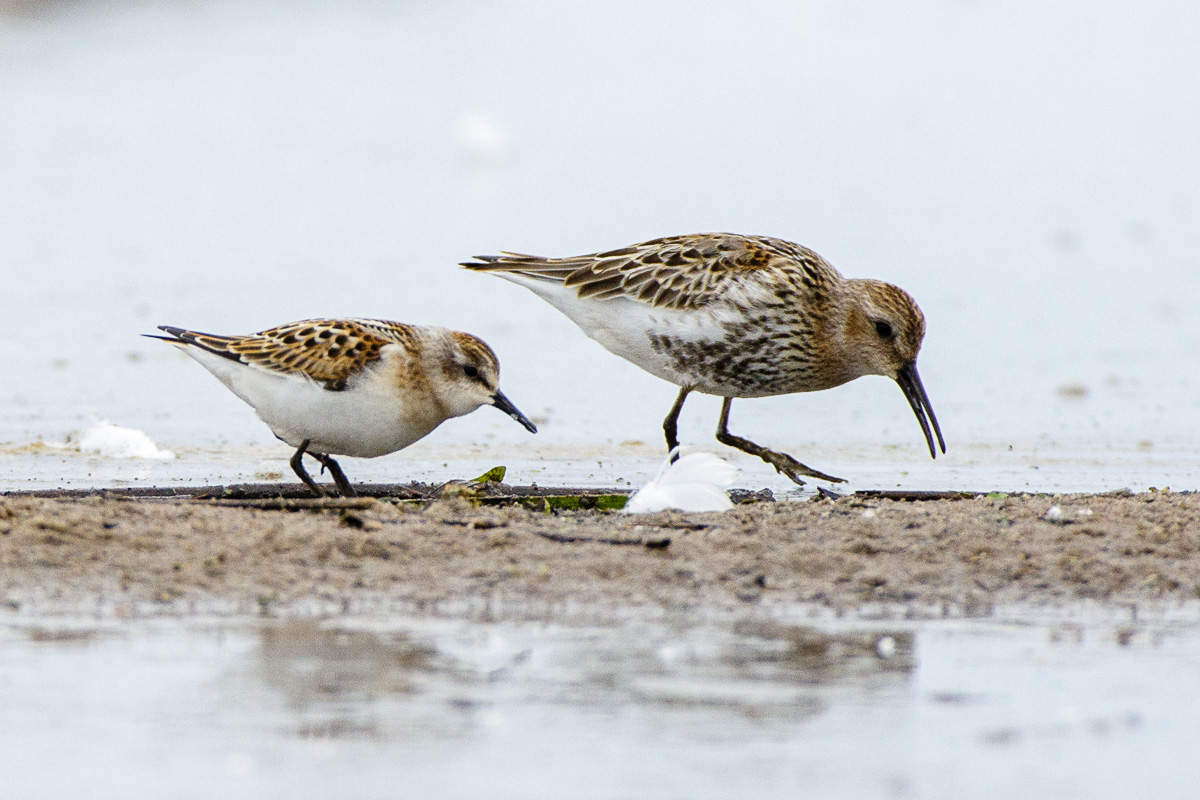|
Stint
A stint is one of several very small waders in the paraphyletic ''"Calidris"'' assemblage – often separated in ''Erolia'' – which in North America are known as peeps. They are Scolopacidae, scolopacid waders much similar in ecomorphology to their distant relatives, the charadriid Charadriidae, plovers. Some of these birds are difficult to identify because of the similarity between species, and various breeding, non-breeding, juvenile, and moulting plumages. In addition, some plovers are also similarly patterned, especially in winter. With a few exceptions, stints usually have a fairly stereotypical color pattern, being brownish above and lighter – usually white – on much of the underside. They often have a lighter supercilium above brownish cheeks. Systematics and taxonomy The genus ''Calidris'' is not monophyletic in its traditional delimitations and should be restricted to the stout red knot and its allies. The genus ''Erolia'' was often used for t ... [...More Info...] [...Related Items...] OR: [Wikipedia] [Google] [Baidu] |
Long-toed Stint
The long-toed stint (''Calidris subminuta'') is a small wader. The genus name is from Ancient Greek ''kalidris'' or ''skalidris'', a term used by Aristotle for some grey-coloured waterside birds. The specific ''subminuta'' is from Latin ''sub'', "near to" and ''minuta'', "small" from its similarity to the little stint, ''Calidris minuta''. It breeds across Palearctic, northern Asia and is strongly bird migration, migratory, wintering in south and south east Asia and Australasia. It occurs in western Europe only as a very rare vagrant. This bird has yellowish legs and a short thin dark bill. Breeding adults are a rich brown with darker feather centres above and white underneath. They have a light line above the eye and a brown crown. In winter, long-toed stints are grey above. The juveniles are brightly patterned above with rufous colouration and white mantle stripes. This bird can be difficult to distinguish from other similar tiny waders which are known collectively as "peeps" ... [...More Info...] [...Related Items...] OR: [Wikipedia] [Google] [Baidu] |
Temminck's Stint
Temminck's stint (''Calidris temminckii'') is a small wader. This bird's common name and Latin binomial commemorate the Dutch naturalist Coenraad Jacob Temminck. The genus name is from Ancient Greek ''kalidris'' or ''skalidris'', a term used by Aristotle for some grey-coloured waterside birds. Temminck's stint is one of the species to which the ''Agreement on the Conservation of African-Eurasian Migratory Waterbirds'' (AEWA) applies. Description These birds are very small waders, at length. They are similar in size to the little stint (''Calidris minuta'') but shorter legged and longer winged. The legs are yellow and the outer tail feathers white, in contrast to little stint's dark legs and grey outer tail feathers. This is a rather drab wader, with mainly plain brown upperparts and head, and underparts white apart from a darker breast. The breeding adult has some brighter rufous mantle feathers to relieve the generally undistinguished appearance. In winter plumage, the genera ... [...More Info...] [...Related Items...] OR: [Wikipedia] [Google] [Baidu] |
Red-necked Stint
The red-necked stint (''Calidris ruficollis'') is a small migratory wader. The genus name is from Ancient Greek ''kalidris'' or ''skalidris'', a term used by Aristotle for some grey-coloured waterside birds. The specific ''ruficollis'' is from Latin ''rufus'', "red" and ''collum'', "neck". Description These birds are among the smallest of waders, very similar to the little stint, ''Calidris minuta'', with which they were once considered conspecific. The red-necked stint's small size, fine dark bill, dark legs and quicker movements distinguish this species from all waders except the other dark-legged stints. It measures in length, in wingspan and in body mass. It can be distinguished from the western sandpiper and the semipalmated sandpiper in all plumages by its combination of a fine bill tip, unwebbed toes, and longer primary projection. The breeding adult has an unstreaked orange breast, bordered with dark markings below, and a white V on its back. In winter plumage identif ... [...More Info...] [...Related Items...] OR: [Wikipedia] [Google] [Baidu] |
Little Stint
The little stint (''Calidris minuta'' or ''Erolia minuta'') is a very small wader. It breeds in arctic Europe and Asia, and is a long-distance migrant, wintering south to Africa and south Asia. It occasionally is a vagrant to North America and to Australia. The genus name is from Ancient Greek ''kalidris'' or ''skalidris'', a term used by Aristotle for some grey-coloured waterside birds. The specific ''minuta'' is Latin for "small. Description Its small size, fine dark bill, dark legs and quicker movements distinguish this species from all waders except the other dark-legged stints. It can be distinguished from these in all plumages by its combination of a fine bill tip, unwebbed toes and long primary projection. The call is a sharp "stit". The breeding adult has an orange wash to the breast, a white throat and a strong white V on its back. In winter plumage identification is difficult. Juveniles have pale crown stripes and a pinkish breast. An apparent hybrid between this ... [...More Info...] [...Related Items...] OR: [Wikipedia] [Google] [Baidu] |
Calidris
''Calidris'' is a genus of Arctic-breeding, strongly migratory wading birds in the family Scolopacidae. These birds form huge mixed flocks on coasts and estuaries in winter. Migratory shorebirds are shown to have decline in reproductive traits because of temporal changes of their breeding seasons. They are the typical " sandpipers", small to medium-sized, long-winged and relatively short-billed. Their bills have sensitive tips which contain numerous corpuscles of Herbst. This enables the birds to locate buried prey items, which they typically seek with restless running and probing. Taxonomy The genus ''Calidris'' was introduced in 1804 by the German naturalist Blasius Merrem with the red knot as the type species. The genus name is from Ancient Greek ''kalidris'' or ''skalidris'', a term used by Aristotle for some grey-coloured waterside birds. The genus contain 24 species: * Great knot, ''Calidris tenuirostris'' * Red knot, ''Calidris canutus'' * Surfbird, ''Calidris ... [...More Info...] [...Related Items...] OR: [Wikipedia] [Google] [Baidu] |
Scolopacidae
Scolopacidae is a large family of shorebirds, or waders, which mainly includes many species known as sandpipers, but also others such as woodcocks, curlews and snipes. Most of these species eat small invertebrates picked out of the mud or soil. Different lengths of bills enable multiple species to feed in the same habitat, particularly on the coast, without direct competition for food. Sandpipers have long bodies and legs, and narrow wings. Most species have a narrow bill, but the form and length are variable. They are small to medium-sized birds, measuring in length. The bills are sensitive, allowing the birds to feel the mud and sand as they probe for food. They generally have dull plumage, with cryptic brown, grey, or streaked patterns, although some display brighter colours during the breeding season. Most species nest in open areas and defend their territories with aerial displays. The nest itself is a simple scrape in the ground, in which the bird typically lays three ... [...More Info...] [...Related Items...] OR: [Wikipedia] [Google] [Baidu] |
Semipalmated Sandpiper
The semipalmated sandpiper (''Calidris pusilla'') is a very small shorebird. The genus name is from Ancient Greek ''kalidris'' or ''skalidris'', a term used by Aristotle for some grey-coloured waterside birds. The specific ''pusilla'' is Latin for "very small". It is sometimes separated with other " stints" in ''Erolia,'' but, although these apparently form a monophyletic group, the present species' old genus ''Ereunetes'' had been proposed before ''Erolia''. Description It is a small sandpiper, long and weighing around . Wingspan ranges from . Adults have black legs and a short, stout, straight dark bill. The body is dark grey-brown on top and white underneath. The head and neck are tinged light grey-brown. This bird can be difficult to distinguish from other similar tiny shorebirds, in particular the western sandpiper; these are known collectively as "peeps" or " stints". Breeding and habitat Their breeding habitat is the southern tundra in Canada and Alaska near water. The ... [...More Info...] [...Related Items...] OR: [Wikipedia] [Google] [Baidu] |
Least Sandpiper
The least sandpiper (''Calidris minutilla'') is the smallest shorebird. The genus name is from Ancient Greek ''kalidris'' or ''skalidris'', a term used by Aristotle for some grey-colored waterside birds. The specific ''minutilla'' is Medieval Latin for "very small". Description This species has yellow-green legs and a short, thin, dark bill. Breeding adults are brown with dark brown streaks on top and white underneath. They have a light line above the eye and a dark crown. In winter, Least sandpipers are grey above. The juveniles are brightly patterned above with rufous coloration and white mantle stripes. This bird can be difficult to distinguish from other similar tiny shorebirds; these are known collectively as "peeps" or "stints". In particular, least sandpiper is very similar to its Asian counterpart, long-toed stint. It differs from that species in its more compact, shorter-necked appearance, shorter toes, somewhat duller colors, and stronger wingbar. Measurements: * Le ... [...More Info...] [...Related Items...] OR: [Wikipedia] [Google] [Baidu] |
White-rumped Sandpiper
The white-rumped sandpiper (''Calidris fuscicollis'') is a small shorebird that breeds in the northern tundra of Canada and Alaska. This bird can be difficult to distinguish from other similar tiny shorebirds; these are known collectively as "peeps" or "stints". These birds are not often spotted. In the summer, they are rarely seen because they are in such an obscure breeding location. Similarly, in the winter they are rarely seen because they travel too far south for many birdwatchers. Therefore, the majority of sightings occur during the spring or fall in temperate regions and are generally in small numbers around water. Taxonomy The white-rumped sandpiper is placed in the order Charadriiformes along with gulls, alcids, plovers and oystercatchers. Its family, Sandpiper, Scolopacidae, encompasses all sandpipers, and as a stint it is classified in the genus Calidrid, Calidris. It is classified as monotypic species, meaning that no population differentiation or subspecies have bee ... [...More Info...] [...Related Items...] OR: [Wikipedia] [Google] [Baidu] |
Sanderling
The sanderling (''Calidris alba'') is a small wading bird. The name derives from Old English ''sand-yrðling'', "sand-ploughman". The genus name is from Ancient Greek ''kalidris'' or ''skalidris'', a term used by Aristotle for some grey-coloured waterside birds. The specific, ''alba'', is Latin for "white". It is a circumpolar Arctic breeder, and is a long-distance migrant, wintering south to South America, South Europe, Africa, and Australia. It is highly gregarious in winter, sometimes forming large flocks on coastal mudflats or sandy beaches. It is somewhat unlike other sandpipers in appearance, which has led to the suggestion that it should be placed into a monotypic genus ''Crocethia''. A more recent review (Thomas ''et al.'', 2004) indicates, however, that the sanderling is a fairly typical "stint" or small sandpiper and should be separated from the large knots with its closest relatives in a distinct genus. This bird is similar in size to a dunlin, but stouter, with a ... [...More Info...] [...Related Items...] OR: [Wikipedia] [Google] [Baidu] |
Curlew Sandpiper
The curlew sandpiper (''Calidris ferruginea'') is a small wader that breeds on the tundra of Arctic Siberia. It is strongly bird migration, migratory, wintering mainly in Africa, but also in south and southeast Asia and in Australia and New Zealand. It is a Vagrancy (biology), vagrant to North America. Taxonomy The curlew sandpiper was species description, formally described in 1763 by the Danish author Erik Pontoppidan under the binomial name ''Tringa ferrugineus''. It is now placed with 23 other sandpipers in the genus ''Calidris'' that was introduced in 1804 by the German naturalist Blasius Merrem. The genus name is from Ancient Greek ''kalidris'' or ''skalidris'', a term used by Aristotle for some grey-coloured waterside birds. The specific ''ferruginea'' is from Latin ''ferrugo, ferruginis'', "iron rust" referring to its colour in breeding plumage. The curlew sandpiper is treated as monotypic: no subspecies are recognised. Within the genus ''Calidris'' the curlew sandpiper i ... [...More Info...] [...Related Items...] OR: [Wikipedia] [Google] [Baidu] |





